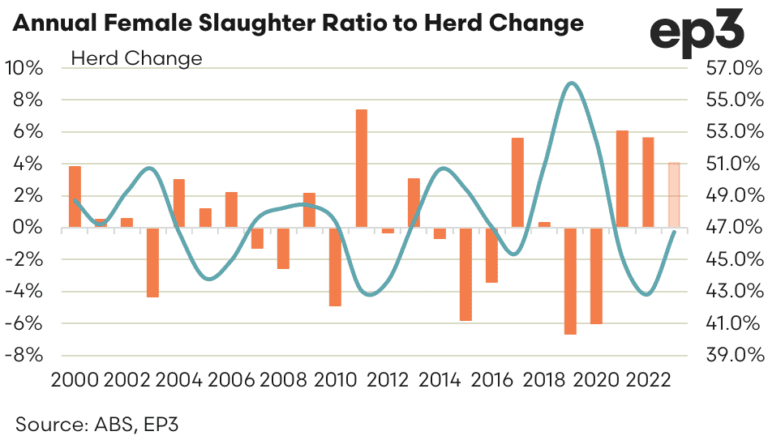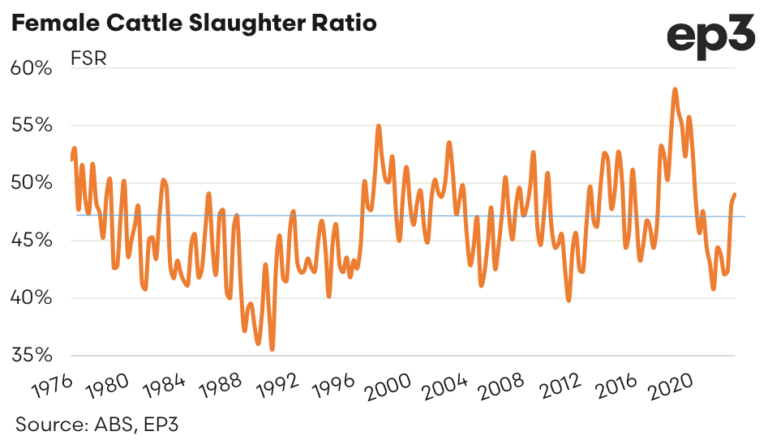
THE Australian beef industry has fallen just short of entering ‘official’ herd reduction following the release of latest quarterly Australian Bureau of Statistics livestock slaughter and meat production volume data this morning.
Third quarter (ended 30 September) data allows measurement of the Female Slaughter Ratio (FSR) for cattle to see how the herd cycle is progressing.
Historically, an annual FSR above 47 percent indicates that Australia’s national beef herd is liquidating, while a lower number indicates a herd in rebuild mode.
Matt Dalgleish from Episode 3 reports that the September quarterly FSR came in at 49pc, up from 48pc in June.
“That brings the annual average FSR to 46.7pc for 2023, just 0.3pc short of signalling a herd liquidation phase has begun,” Mr Dalgleish said.
MLA earlier suggested that like economic measures of recession – where two consecutive quarters of negative growth earn an ‘official’ recession status – two quarters of FSR above 47pc could also be seen as an ‘official’ start to herd decline.
Many had anticipated that metric would be reached in the September quarter. Even at 48-49pc on a quarterly basis, the indicator suggests only mild herd reduction is now occurring. Worth noting, however, is the fact that each Australian state has dramatically different FSR figures indicating herd expansion or contraction, as outlined in this earlier Beef Central article.
Weekly national slaughter data compiled by the National Livestock Reporting Service (note: some processors, representing about 15-20pc of national kill, choose not to contribute data) suggests there have only been a handful of weeks this year when the FSR has reached or exceeded 47pc.
During the 2019 drought the beef herd hit a record high FSR of 56pc (see graph below).

Episode 3 noted that Meat & Livestock Australia had been forecasting a 4pc increase to the national herd over calendar 2023.
“However, historically an annual average FSR nearer to 47pc would be more consistent with only marginal herd growth (circa 1pc, or less),” Mr Dalgleish said.
“As the year progresses, if the FSR continues to trend higher we may see MLA shave off some of the growth projections on the herd for this year.”
Lotfeeding activity provides a pointer
Additionally, this week’s release of the latest quarterly cattle on feed survey for the quarter ended 30 September allowed measurement of how many grainfed cattle are being turned off this year, as a percentage of total turnoff.
“The September quarter saw grainfed turnoff ease, and this has seen the grainfed ratio (as a proportion of all beef produced) slip from an annual average of 46.9pc in 2022 to 38pc so far this year – the lowest level seen since the 2019 drought,” Mr Dalgleish said.
“In terms of total adult cattle numbers (year to date to September 2023) we have seen 5.18 million head processed across Australia, of which 1.97 million were grainfed and 3.21 million of grass finished cattle.”
The downwards trend in the grainfed ratio since the March quarter is clearly evident in the Ep3 graph below.

